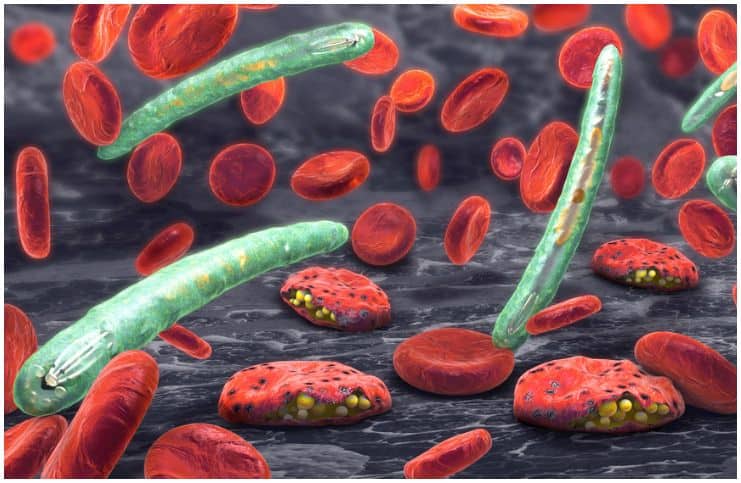Malaria
It is a life-threatening disease that is caused by parasites that are transmitted to adults and children through the bites of infected female Anopheles mosquitoes.
Worldwide, about 3.2 billion people in 95 territories and countries are at risk of being infected with this disease and 1.2 billion are at high risk. Approximately 438,000 people died of this condition in 2015, according to the World Health Organization.
90 percent of deaths due to this infection occur in Africa. For example, it accounts for about 20 percent of childhood deaths. Also, it contributes considerably to anemia among children.
This infection was eliminated from the United States in the early 1950s. Nevertheless, about 2,000 cases still occur every year, in people who have traveled to malaria-endemic areas.
Symptoms
Common symptoms may include:
- muscle aches;
- abdominal pain;
- poor appetite;
- chills and sweats (every 48 or 72 hours, depending on species);
- low blood pressure;
- high fever;
- headache;
- vomiting;
- nausea;
- diarrhea.
Neurologic defects may sometimes persist following cerebral malaria, particularly in children, and include – palsies (accompanied by uncontrolled body movements), trouble with movements (ataxia), deafness, speech difficulties, and blindness.
Causes
The parasite is spread by female Anopheles mosquitoes, that bite mainly between dusk and dawn. Once an infected female Anopheles mosquito bites a human, the parasites multiply in the host’s liver before infecting and destroying erythrocytes (better known as red blood cells).
Within 48 to 72 hours, this parasite inside the erythrocytes multiplies, causing the infected cells to burst open.
There are 5 species of the Plasmodium parasite that can cause this condition in humans:
#1 Plasmodium falciparum
It is found mainly in the subtropics and tropics (near the equator) and usually has a short incubation period (up to two weeks).
#2 Plasmodium vivax
It is mainly found in South America and Asia and causes milder symptoms than P. falciparum, however, it can stay in the liver for more than 3 years, which can result in relapses. The incubation period for Plasmodium vivax is typically 10 to 17 days.
#3 Plasmodium ovale
It is generally considered to have a relatively limited distribution, being limited to areas of New Guinea, tropical Africa, the Philippines, and the eastern parts of Indonesia.
#4 Plasmodium malariae
It is the one of the least studied of the species of this parasite which infect humans, due to its milder clinical manifestations and low prevalence.
#5 Plasmodium knowlesi
It is usually found in the Philippines, Malaysia, and Southeast Asia, and can cause high levels of parasites in the blood. P. knowlesi infection can lead to organ failure or death.
Treatment
It is treated with anti-malarial drugs given by injection, by mouth, or intravenously, depending on the type of parasite causing the infection.
Prevention
The risk of this infection can be considerably lowered by preventing mosquito bites through the use of insect repellents and mosquito nets as well as draining standing water.
Yellow Fever
It is a viral infection spread by Aedes aegypti mosquito. More than 200,000 individuals people become infected per year, according to the World Health Organization. It is common in sub-Saharan Africa and South America. 1905 was the year of the last major outbreak in the United States.
Symptoms
The period of time from contracting the infection to the development of signs and symptoms is typically between 3 to 6 days. They include:
- feeling generally unwell;
- loss of appetite;
- a high temperature of 38C (100.4F);
- eyes being sensitive to light;
- headache;
- backache;
- muscle pain;
- vomiting.
Most patients make a full recovery after 3 or 4 days. However, a small percentage of sufferers enter the second phase within 24 hours of recovering from the first signs and symptoms.
Symptoms in the 2nd phase may include:
- yellow eyes or skin (jaundice);
- high fever returns;
- bleeding problems;
- itching;
- headache;
- weakness;
- drowsiness (excessive sleepiness);
- back pain;
- abdominal pain;
- vomiting;
- nausea.
Approximately 50 percent of the patients who enter the second phase die within two weeks, the rest recover without notable organ damage.
Causes
You can develop this condition if you are bitten by the Aedes aegypti mosquito infected with this virus, a single-stranded RNA virus that belongs to the Flavivirus genus.
Infected people cannot spread this infection to other people through casual contact, however, it can be transmitted into the blood through contaminated needles.
Treatments
No treatments have been found to benefit sufferers with this condition. Nevertheless, patients should be hospitalized for supportive care to help reduce a high temperature (by drinking plenty of fluids to avoid dehydration) and muscle pain (using ibuprofen or paracetamol).
Prevention
Methods to prevent this infection include wearing protective clothing and using insect repellent. Also, stay away from areas that have a large mosquito population and standing bodies of water. In addition, wear long pants and long-sleeved shirts when outdoors.
Malaria vs Yellow Fever – Differences
Both are transmitted by mosquitoes (although different ones), however, yellow fever is caused by a virus, and malaria is caused by a parasite – plus, it can be deadly.
Images credit – Shutterstock
READ THIS NEXT: Magnesium Orotate – Side Effects And Benefits
References http://www.cidrap.umn.edu/news-perspective/2017/03/studies-show-single-new https://www.ncbi.nlm.nih.gov/pubmed/19967234 http://www.who.int/malaria/areas/treatment/drug_efficacy/en/
